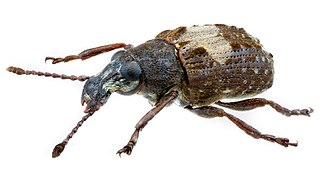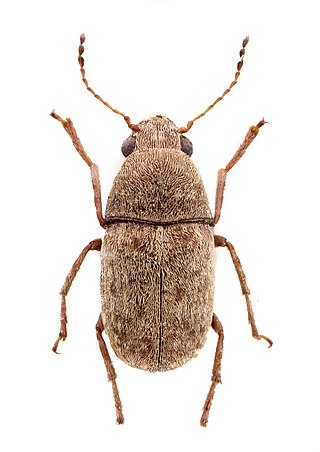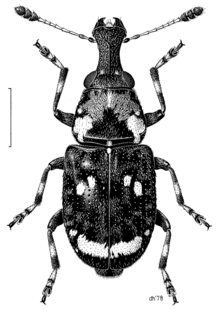
Weevils are beetles belonging to the superfamily Curculionoidea, known for their elongated snouts. They are usually small – less than 6 mm in length – and herbivorous. Approximately 97,000 species of weevils are known. They belong to several families, with most of them in the family Curculionidae. It also includes bark beetles, which while morphologically dissimilar to other weevils in lacking the distinctive snout, is a subfamily of Curculionidae. Some other beetles, although not closely related, bear the name "weevil", such as the biscuit weevil, which belongs to the family Ptinidae.

The insects of the beetle family Chrysomelidae are commonly known as leaf beetles, and include over 37,000 species in more than 2,500 genera, making up one of the largest and most commonly encountered of all beetle families. Numerous subfamilies are recognized, but the precise taxonomy and systematics are likely to change with ongoing research.

Nemonychidae is a small family of weevils, placed within the primitive weevil group because they have straight rather than geniculate (elbowed) antennae. They are often called pine flower weevils. As in the Anthribidae, the labrum appears as a separate segment to the clypeus, and the maxillary palps are long and projecting. Nemonychidae have all ventrites free, while Anthribidae have ventrites 1-4 connate or partially fused. Nemonychidae lack lateral carinae on the pronotum, while these are usually present, though may be short, in Anthribidae.

Platystomos wallacei is a species of beetle belonging to the family Anthribidae, the fungus weevils.

Platystomos albinus is a species of beetle in the family Anthribidae, the fungus weevils. Adults measure 7 to 10 mm (0.3–0.4 in). The larvae feed on decaying trees, and are associated with the fungus Daldinia. It is present in deciduous forests throughout Europe and the Near East, including central southern and eastern Britain.
Euparius paganus is a species of fungus weevils in the family Anthribidae. It is found in North America.

Euparius is a genus of fungus weevils in the family Anthribidae. There are at least 6 described species in Euparius.

Anthribinae is a subfamily of fungus weevils in the family of beetles known as Anthribidae. There are over 50 genera and more than 80 described species in Anthribinae.

Piesocorynus plagifer is a species of fungus weevils in the family Anthribidae. It is found in North America.

Piesocorynus is a genus of fungus weevils in the family Anthribidae. There are about 5 described species in Piesocorynus.
Piesocorynini is a tribe of fungus weevils in the family Anthribidae. There are at least 2 genera and about 8 described species in Piesocorynini.
Ormiscus albofasciatus is a species of fungus weevil in the beetle family Anthribidae. It is found in North America.

Euparius marmoreus is a species of fungus weevil in the family of beetles known as Anthribidae. It is found in North America.

Gonotropis dorsalis is a species of fungus weevil in the family of beetles known as Anthribidae.

Gonotropis is a genus of fungus weevils in the family of beetles known as Anthribidae. There are about five described species in Gonotropis.

Toxonotus is a genus of fungus weevils in the beetle family Anthribidae. There are about 13 described species in Toxonotus.

Toxonotus cornutus is a species of fungus weevil in the beetle family Anthribidae. It is found in Central America, North America, and Oceania.

Choraginae is a subfamily of fungus weevils in the beetle family Anthribidae. There are about 9 genera and more than 180 described species in Choraginae.
Trigonorhinus griseus is a species of fungus weevil in the Anthribidae family of beetles. It is found in Central America and North America.
Ormiscus saltator is a species of fungus weevil in the beetle family Anthribidae. It is found in North America.
















